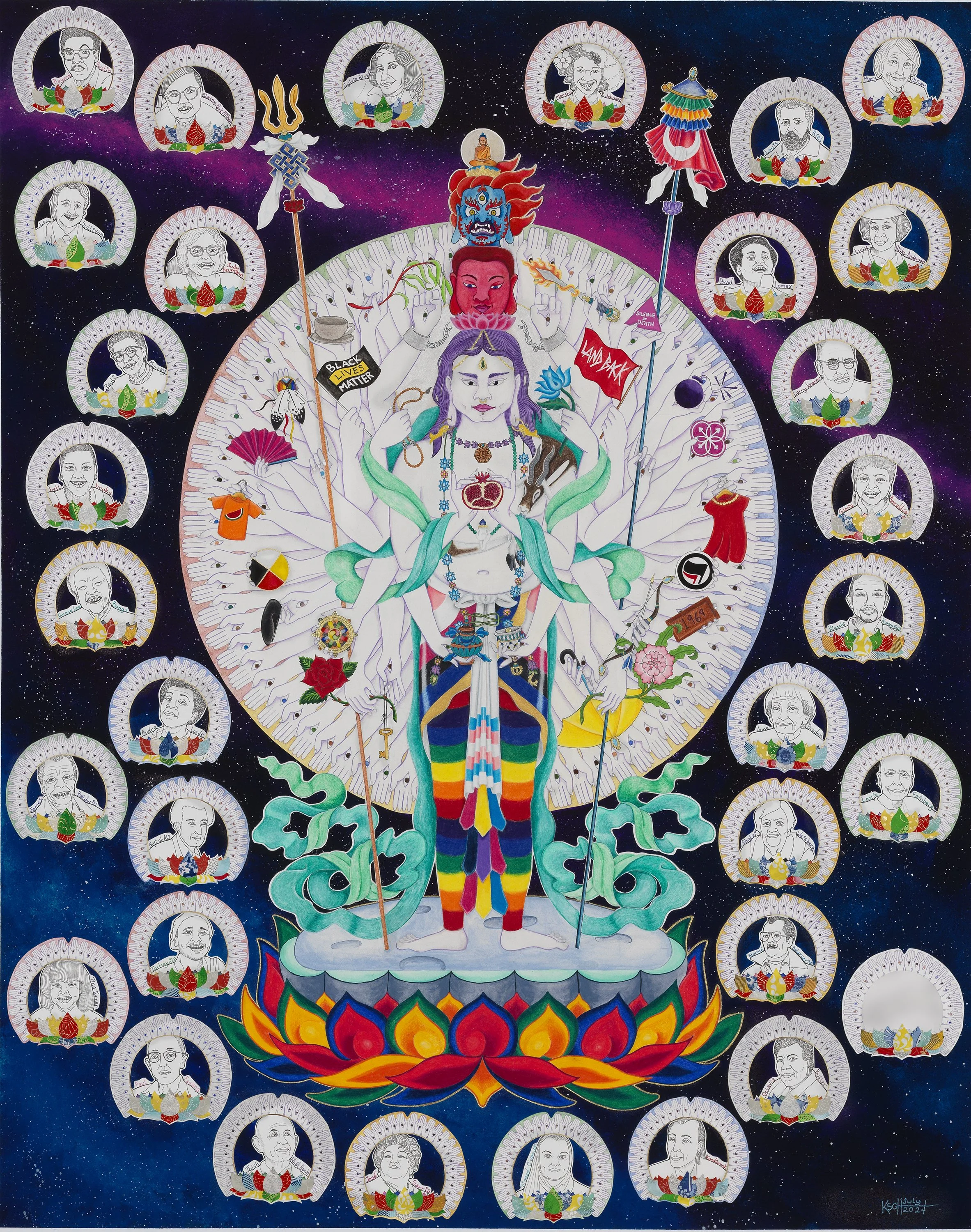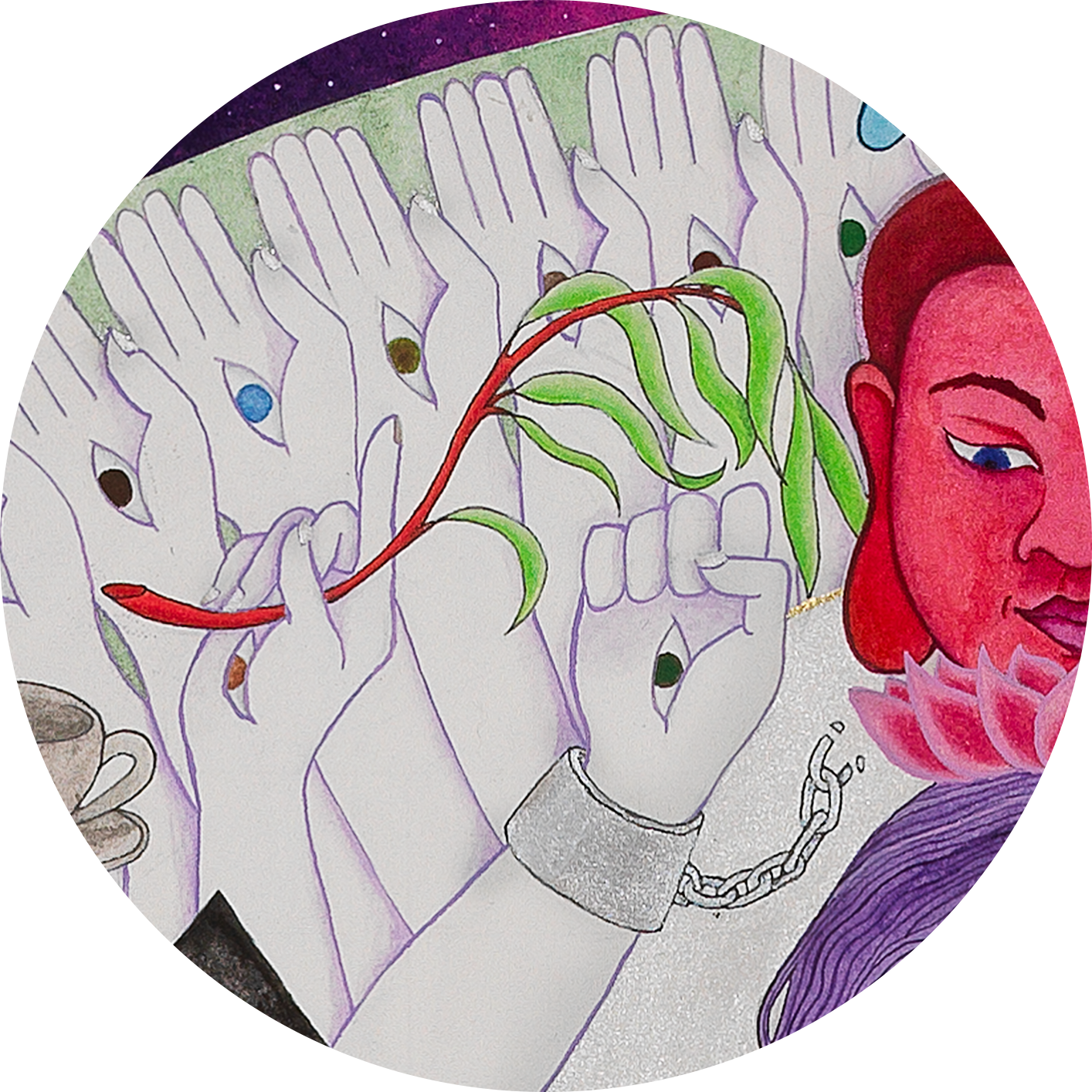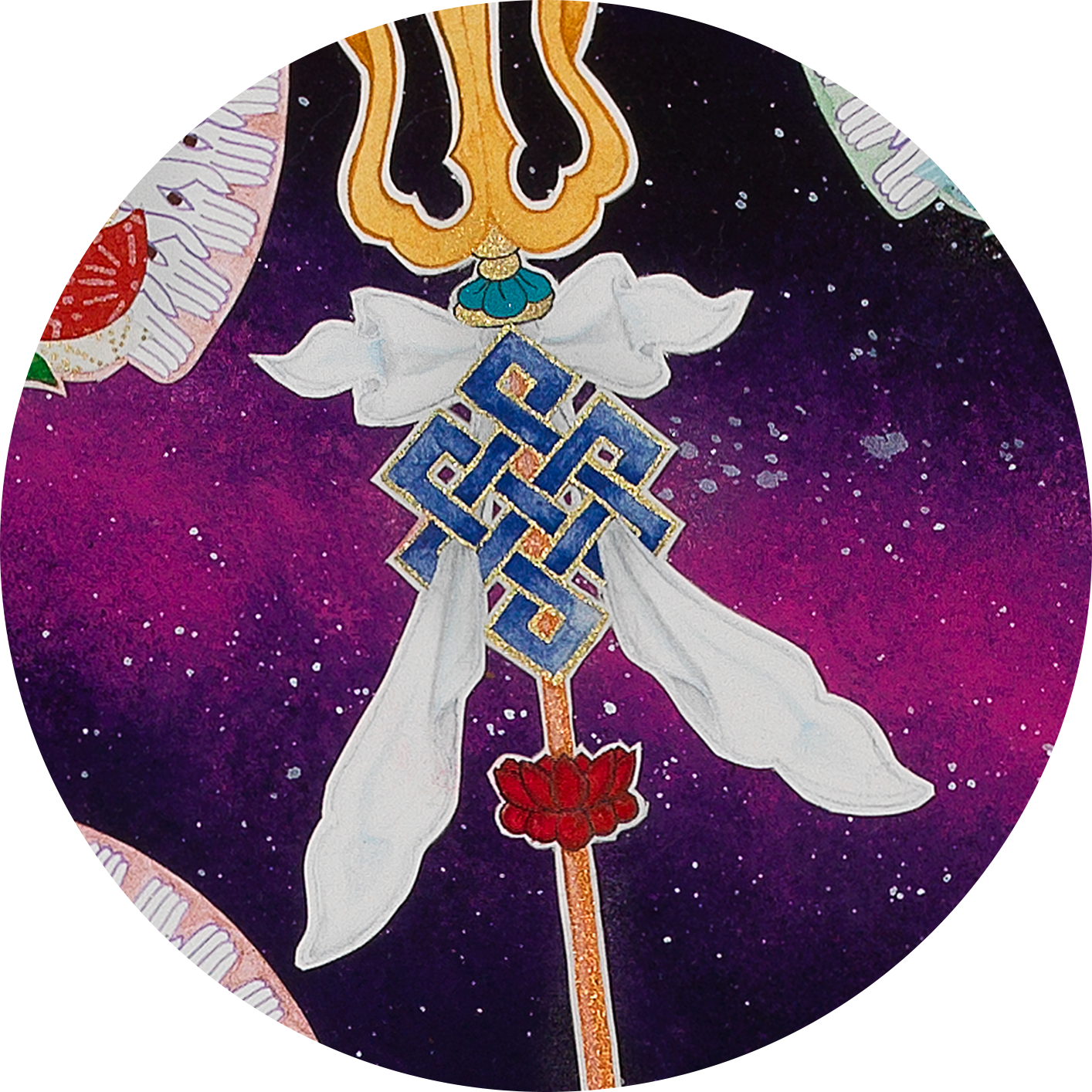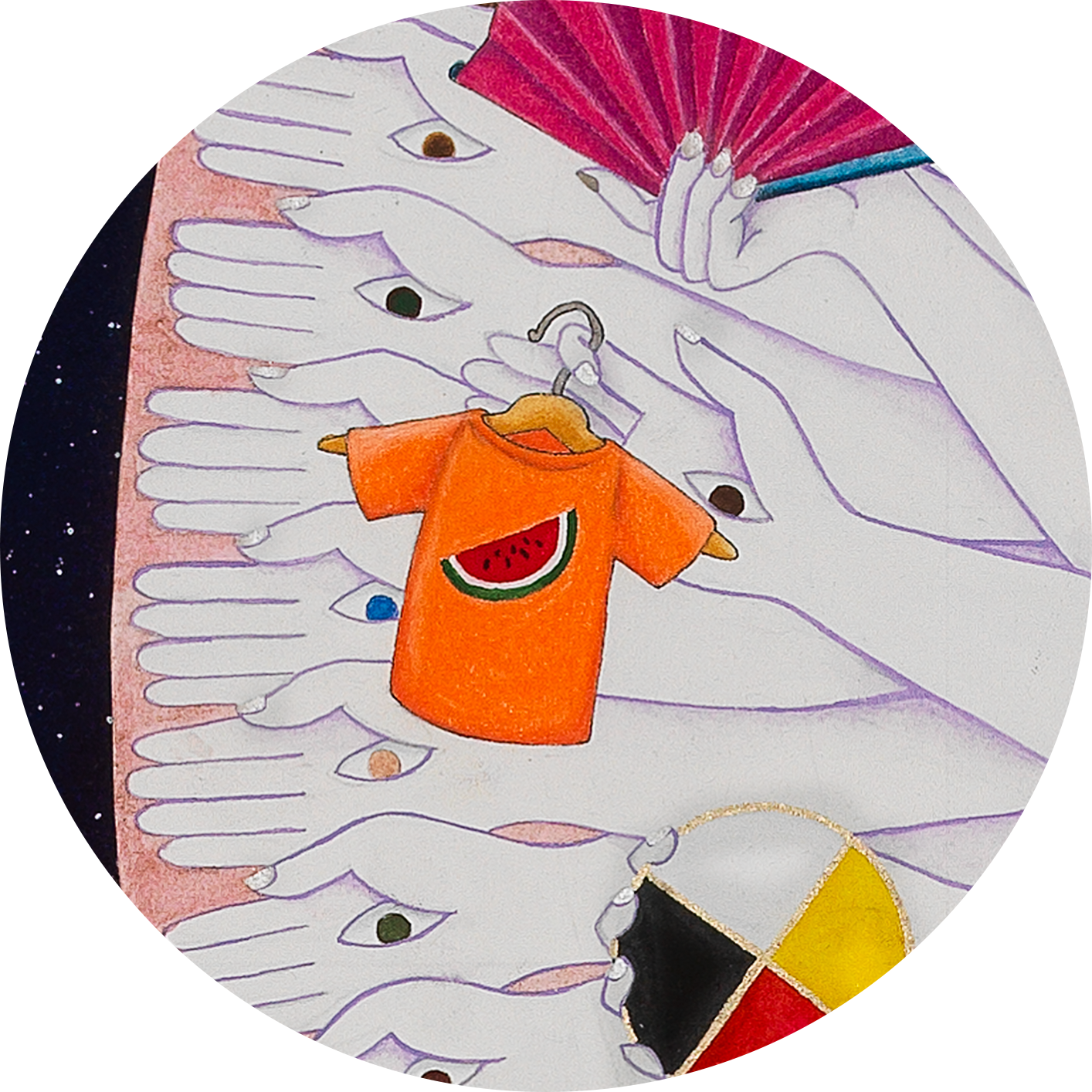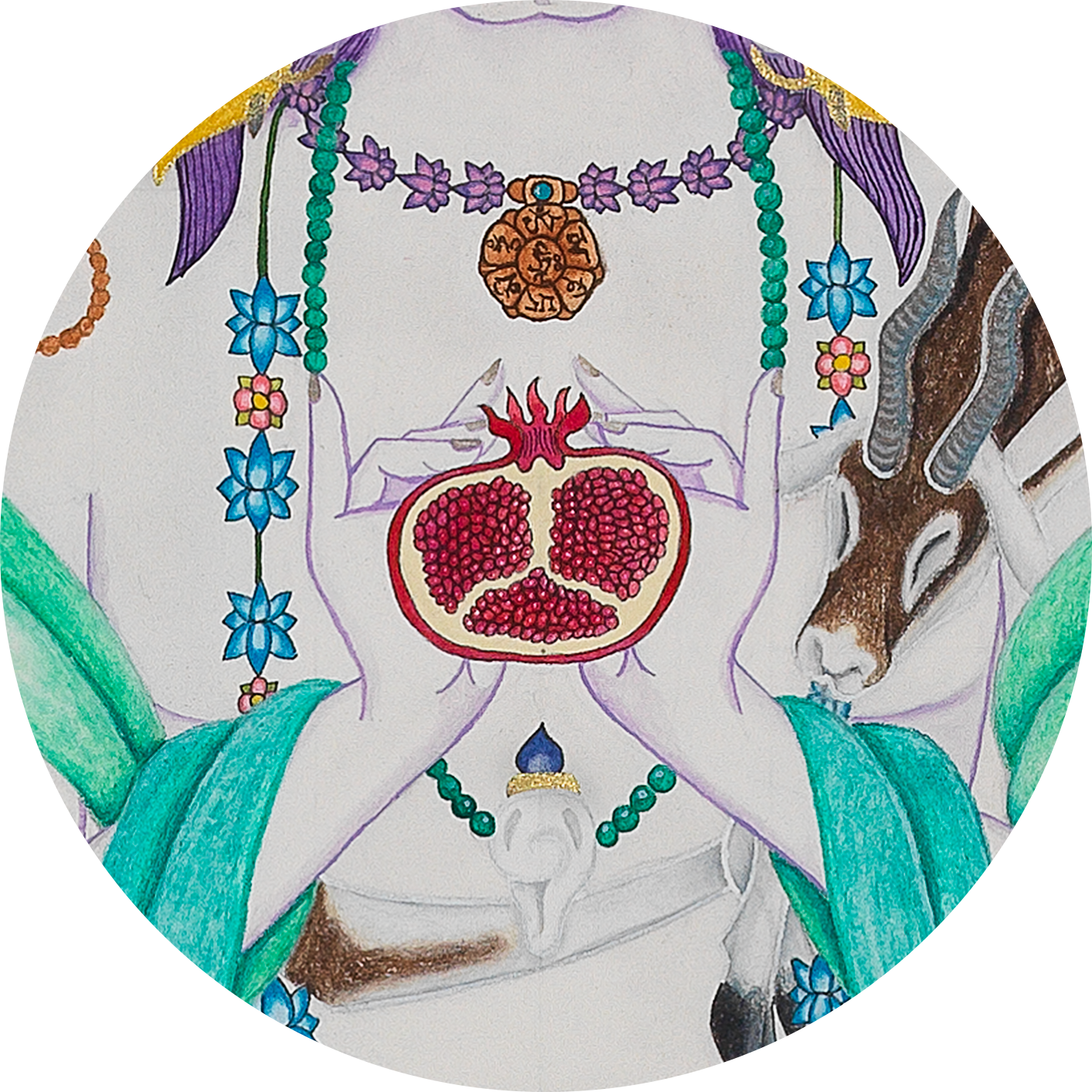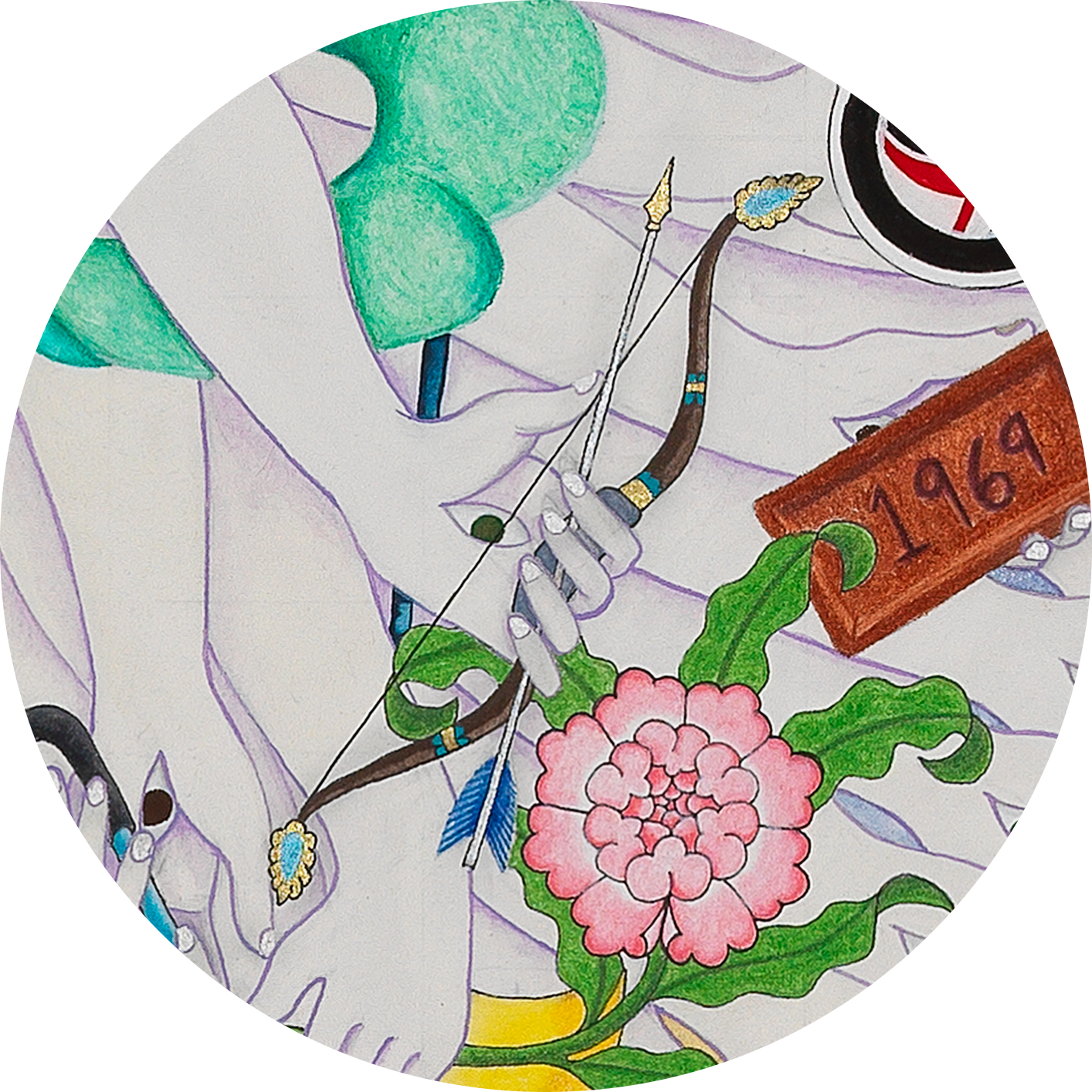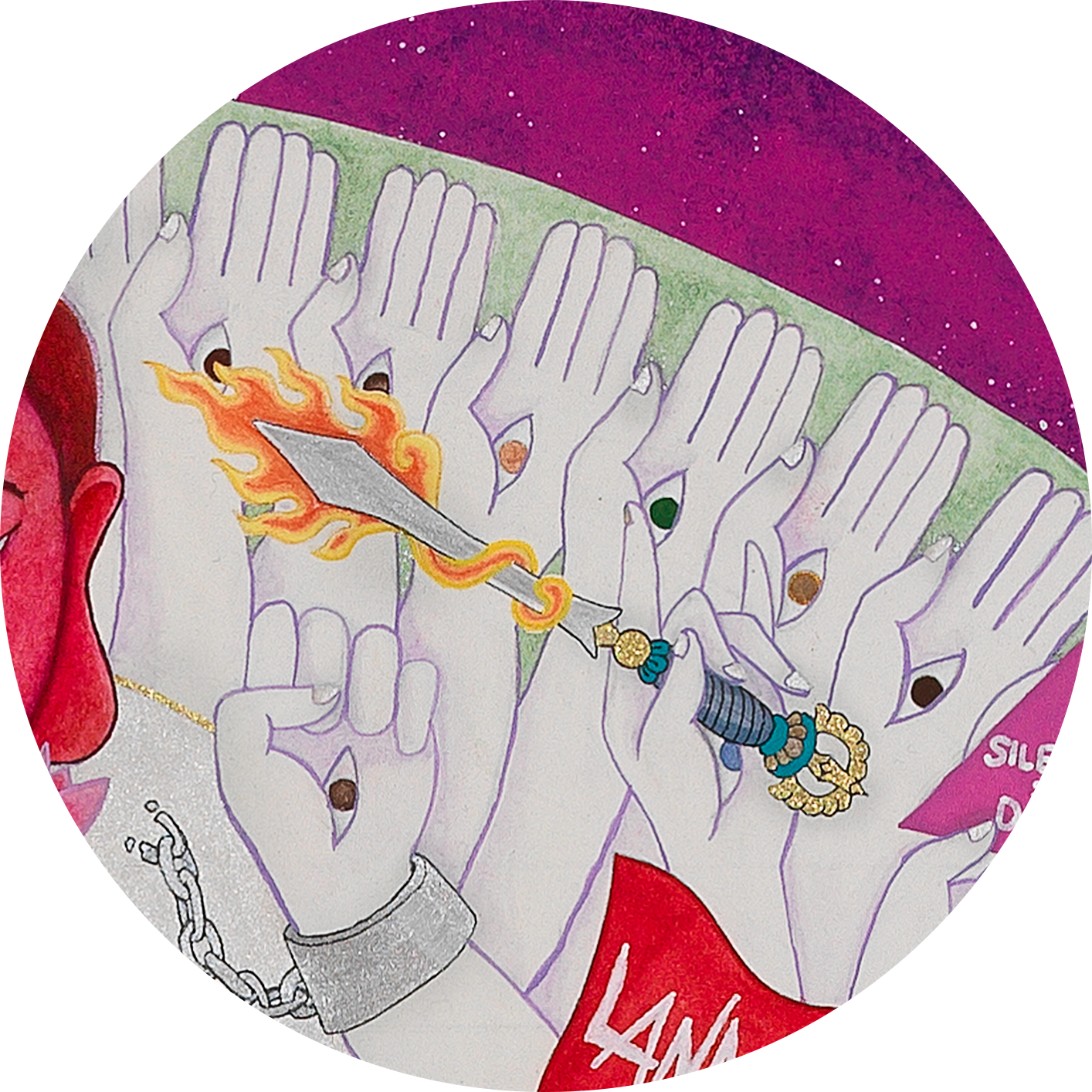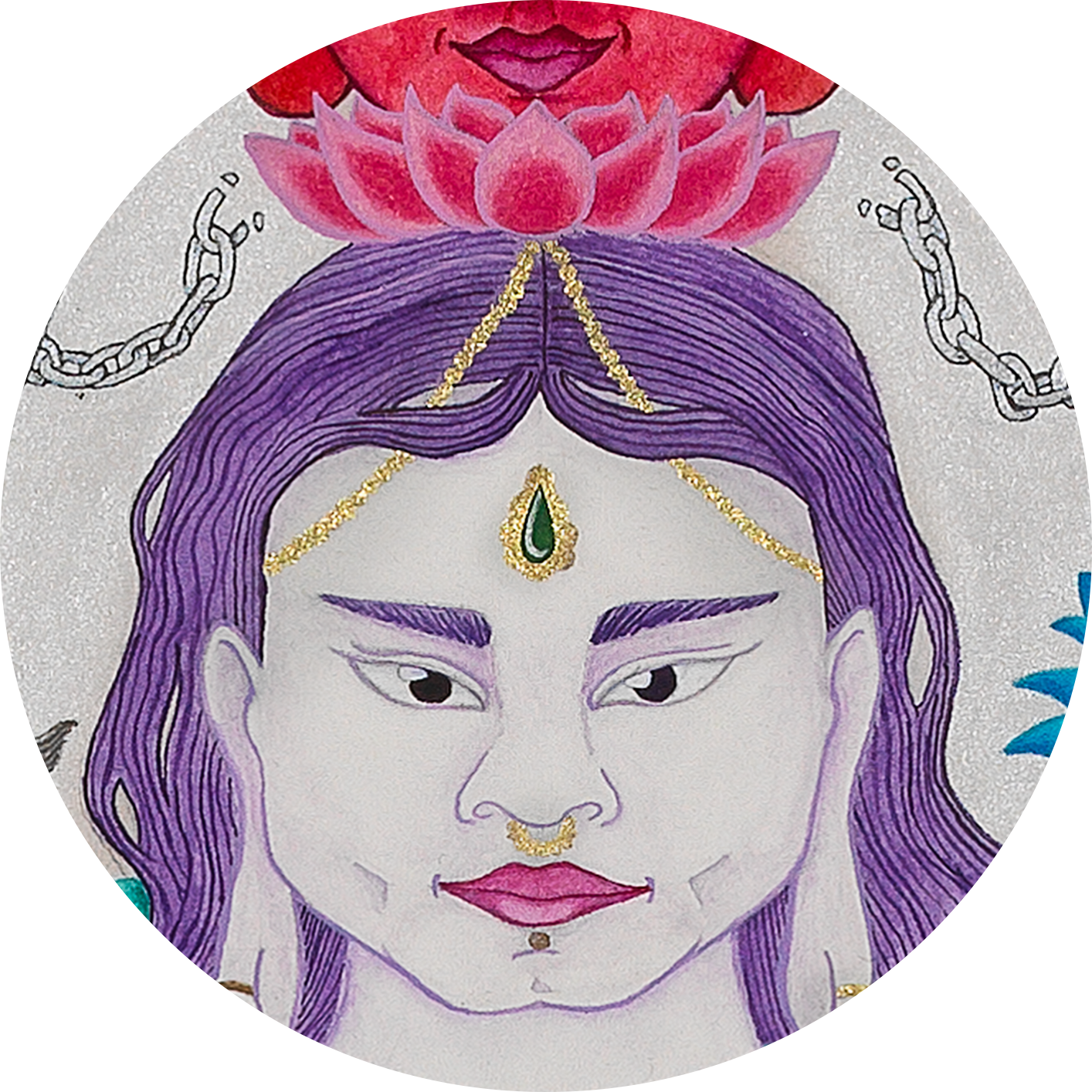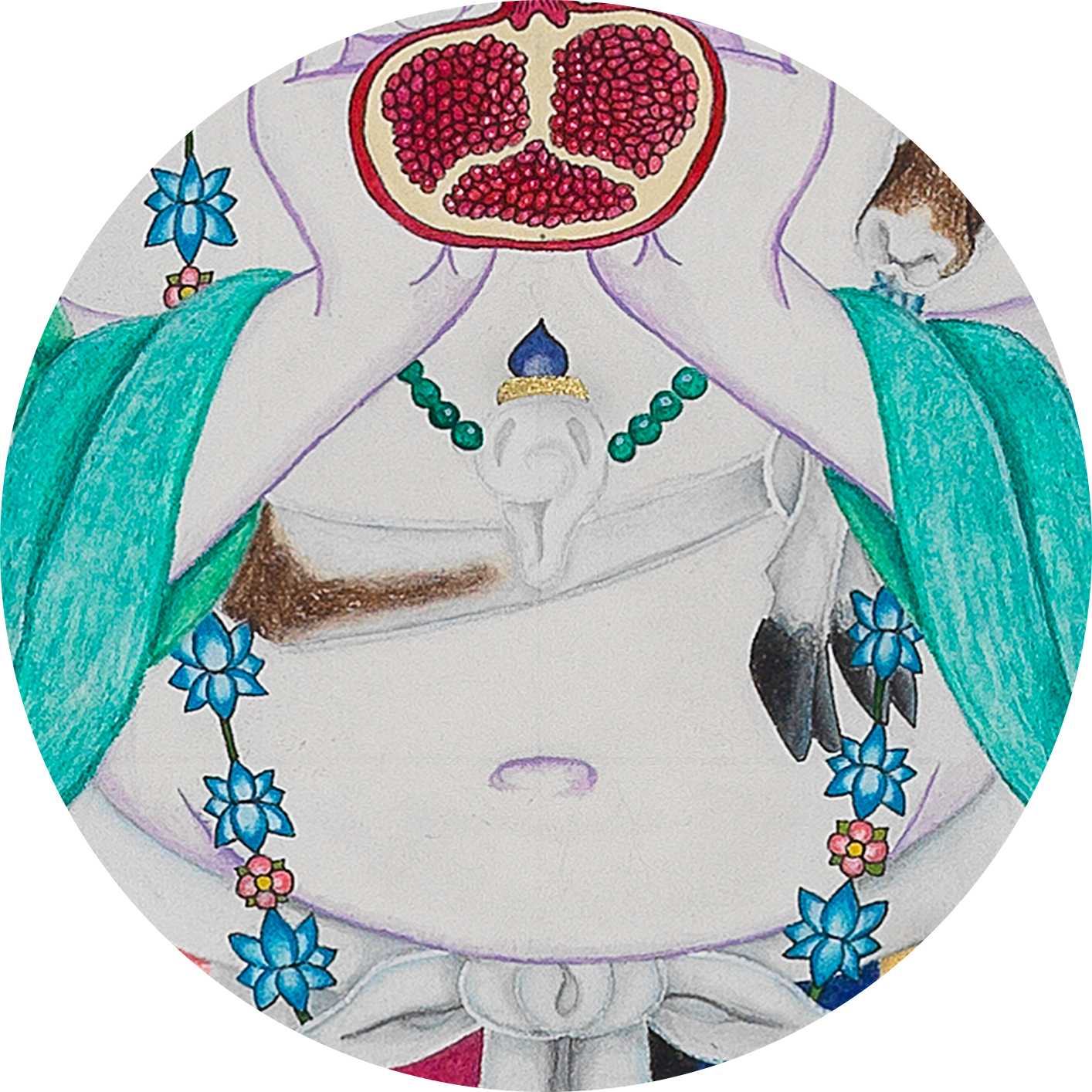The following is a guide to the symbols in this piece. This list begins with the items in the foremost hands in a counter-clockwise shape, starting at the two hands at the top of the image and moving around. Then it moves to the adornments Avalokiteshvara is wearing on their body. This website is optimized for laptop or desktop viewing.
The left side hands, or West side, represent the Buddha Amitabha and qualities of love, compassion, community, and belonging. The right side or Eastern hands represent the Buddha Akshobya and qualities of protection, resistance, clarity and justice.
The symbols chosen for this piece are a mix of traditional and contemporary symbols. The traditional symbols come from various depictions of Avalokiteshvara across the world, from Tibet to China, Korea, Vietnam, Thailand and Japan, while the more contemporary symbols come from the 19th century onward and are connected to many of the movements the various ancestors come from, predominantly within so-called Canada and the United States.
Practice Guide & Questions to Carry
As you look at the main image of Avalokiteshvara, notice which symbol or symbols stand out to you. Look away from the image and take time to write down all the symbols you recall. Then spend some time in contemplation and reflection with any of the questions below.
What is it about the symbols that stand out to you?
Are they familiar or unfamiliar?
How do they make you feel?
Do you notice any discomfort?
Are you or a community you belong to reflected in the symbolism chosen?
WEST/LEFT HANDS
Broken Chains
Representative of freedom from slavery. Broken chains are both historical and contemporary, as they are often used as a representation for an end to modern forms of incarceration and freedom from chattel slavery.
Willow Switch
Rich with meaning, the willow switch is almost always present in depictions of Avalokiteshvara. It represents compassion, flexibility, impermanence, and protection. Willow switches or representations of them are often used in Buddhist ceremonies.
While working on this piece, the patron for it shared with the artist about a a self-guided sculpture walk in Greensborough, North Carolina. Seven sculptures commemorate the sit-in movement to fight for desegregation in the United States. Often when we learn about the struggle for justice and liberation, specific people are upheld as symbols of particular movements. These sculptures, and the inclusion of a coffee cup in this piece, remind us of the everyday, unnamed people that are part of any movement for social change.
Coffee Cup
Mala Beads
Traditional beads used by Buddhist monastics and lay practitioners to count mantras during chanting or meditation.
Black Lives Matter flag
Representative of the contemporary movement to end police violence against Black and brown communities, BLM originated in the United States and was picked up globally in the wake of a cop murdering George Floyd in 2020 in broad daylight with many witnesses.
Two Spirit/Progress Pride flag
“Two-spirit” is a contemporary term that came into use in 1992 as a kind of catch-all for the many different genders recognized by various Indigenous nations throughout Turtle Island. The two feathers is the most recognizable symbol used by the two-spirit community, and here it has been combined with the progress pride flag (designed by Daniel Quazar) in a circle.
Trident
The use of the trident in Buddhist iconography is said to have originated with depictions of Shiva in Hinduism. Avalokiteshvara is thought to have evolved from images of Shiva, so they are often holding the trident. The three prongs can also represent taking refuge in the Buddha, the Dharma (teachings) and the Sangha (Community of practitioners), and it is considered a symbolic weapon against the three poisons of the mind: passion, aggression and ignorance.
Infinity Knot
The infinity knot, or eternal knot, represents the interconnectedness and interdependence of all phenomena and existence.
Hand fan
In drag culture, hand fans are used to communicate quite a lot. As with snapping fingers to show agreement, snapping a hand fan is a way to show solidarity or to set boundaries. In modern times, hand fans can have slogans printed on them, such as “Protect Trans Rights” or “Vote Like Your Rights Depend On It.” Activism has been a core part of drag culture since it’s origins in the communities of formerly enslaved Black folks in the United States.
Every Child matters from the river to the sea
During the time the artist was working on this piece, the Israeli military began disproportionate and horrifying bombardment of the Palestinian people in retaliation for an attack from Hamas. The ongoing genocide of the Palestinian people and atrocious war-crimes of the fascist Israeli government have been shared through social media platform since October 2023. Much of the footage shared is of Palestinian children Israeli soldiers have shot, bombed, and killed.
As support for the Palestinian people has grown, so has suppression of protests agains the genocide. The symbol of the watermelon was adopted online as way to bypass shadowbanning various social media platforms have tried to enact when people use phrases like “Free Palestine”, “Ceasefire Now” or “From the River to the Sea”.
Since the colonization of the Americas/Turtle Island, Australia, and Aotearoa began, the colonizing governments have enacted sweeping decrees and laws to take Indigenous children from their families for “re-education” in white-run, often religious schools. Nuns, priests and teachers in these schools treated these children terrible, often abusing them physically and sexually.
In Canada, the orange shirt has become a symbol of the grief, rage, and trauma this colonial practice inflicted on Indigenous communities across Turtle Island. It is worn to show solidarity for the living survivors of the Residential School system and the 60’s scoop. The slogan that accompanies this symbol is “Every Child Matters” as a direct counter to the indifference and hostility of the people who caused the deaths of these children.
The artist combined the symbols of the watermelon and the orange shirt in a symbol they now think of as “Every child matters from the river to the sea.”
Medicine Wheel
The medicine wheel, or sacred circle, is a symbol dating back as early 4000 B.C. It was used by many different tribes and nations for many different reasons, from marking the grave of a beloved tribal leader, to tracking seasonal changes, to ceremonial sites. They can often represent the seasons (Yellow for spring, red for summer, black for autumn and white for winter) or the directions of north, south, east and west.
The artist chose this symbol because of the connection they had to it through the high school they attended, where a version known as the Circle of Courage was used as a model for the school culture and principles. The four quadrants of the circle of courage stand for belonging (Community, care for others), mastery (Confidence and striving to be better, not superior), independence (Discipline and self-awareness of personal work to be done) and generosity (Collaboration, being able to give away what you cherish, and joy in contributing to the community). Their time at this school helped build the foundation of their activist practice, and they credit much of that to the way these principles were shared and talked about.
black Beret
The Black Panther movement was primarily focused on mutual aid for Black communities in the United States and protecting Black people from police and white supremacist violence. Their free lunch programme was community-changing for the thousands of children who accessed it during its operation, until the FBI infiltrated and destroyed the group.
The black beret was a key part of the Panther uniform, alongside sunglasses and black leather jackets. Despite being formed as a way to protect and provide for their communities, the Panthers have long been portrayed in popular (see white) media as an aggressive militant group. But because the organization was primarily one of community care and support, the artist chose to place the beret in a hand on the left side of Avalokiteshvara, the side associated with the Buddha Amitabha, representing deep abiding love and compassion.
Dharmachakra
One of the eight auspicious symbols that originated from India, the Dharmachakra or Dharma wheel represents the teachings of the Buddha and spiritual transformation.
Rose
The red rose has been used as a symbol for labour movements and unionizing for going on three centuries now. While this symbol is also associated with the Labour Party in the UK, the artist chose it primarily for how it has been used specifically by working women in various fights for fair wages, safer working conditions, and women’s suffrage for non-land owning women.
The poem “Bread and Roses” by James Oppenheim was taken up as a slogan by union organizers and eventually turned into a song. To this day, the song and the symbol of the rose are used by those fighting for a more socialist system where workers are paid fairly for their labour and women in particular might see pay equity.
Key
Since the 1948 Nakba, Palestinian people have used a key as a symbol of their sovereignty. The key represents a return of Palestinians to their homelands and has been taken up by many cultures as a representation of their continued existence in the face of genocidal and colonial oppression.
MIDDLE HANDS
Pomegranate
Many Buddhist texts include references to the seeds of dharma and the ripening of karmic fruit. The artist reached out to members of their dhama family and asked them to share what fruit they felt would be most representative of both these concepts. One of the artists dharma kin came back with the suggestion of the pomegranate because of the rich meaning it holds not just within Buddhism, but across many faiths and cultures.
The pomegranate most often represent abundance, which is fitting for an image of the Thousand-Armed Avalokiteshvara, the embodiment of all the compassion of all the Buddhas.
Vase & Bell
One of the eight auspicious symbols that originated from India, the vase represents the bountiful teachings of the Buddha. The bell is a symbol common in Vajrayana Buddhism. It represents clarity of understanding emptiness, or Shunyata in Sanskrit.
EAST/RIGHT HANDS
Umbrella/Parasol
The Umbrella has been a symbol of suffrage for generations and across cultures, from white women in the UK in the early 1900s to the citizens of Hong Kong in 2019 and 2020. As one of the eight auspicious symbols, the parasol represents protection from suffering, as well as showing dignity.
Peony
Buddhist imagery is always rich with flowers of all kinds, but particularly the many-petalled variety. Flowers in general represent impermanence and enlightenment, and are used as offerings. The peony represents enlightenment and good fortune, and pink represents compassion, love and devotion.
Manjushri’s bow & arrow
The Bodhisattva Manjushri is the artist’s Yidam Deity and so it felt essential to include some aspect of this powerful being in this piece.
This piece features both Manjushri’s bow and arrow and Manjushri’s sword. The Simhanada Manjushri form, or red-bodied Manjushri, depicts the bow and arrow, held in one of two right hands (the figure has four arms). The two items represent focus and accuracy, as well as integrating what we learn on the path into our lives.
1969 Brick
While the Stonewall Uprising was not the first queer revolt against police and societal oppression, it was the flashpoint that changed the movement for queer and trans liberation in the United States. Lead primarily by Black and Latina trans women and poor queer community members, the Stonewall revolt marked a shift in the culture and a refusal of queer people to continue to suffer under the targeted violence of the culture, as it was enforced and carried out by police.
Anti-Fascist Symbol
Since the 1930s rise of fascism, we have had resistance to fascism. The movement for antifascism has had many different symbols around the world as it has cropped up anywhere it was needed. This particular design came out of Nazi Germany and has gained traction with modern antifascist groups throughout Europe and the United States and Canada.
Red Dress
In Canada, May 5th is the National Day of Awareness for Missing and Murdered Indigenous Women and Girls, also known as “Red Dress Day”. Under white supremacy culture, a disproportionate number of Indigenous people go missing, and often their disappearances are not investigated by police. The crisis caused by the neglect of police departments and politicians led to a growing movement to raise awareness of this issue and change the culture at large. The movement gained national attention in 2004 following a report from Amnesty International. Métis artist Jaime Black created the REDress Project in response to the report and as a way of depicting the loss of more than 1,000 missing and murdered Aboriginal women in Canada.
Victory Banner
One of the eight auspicious symbols that originated from India, victory banners are commonly found in monasteries and temples. It represents the historical Buddha’s victory over Mara, or victory over the kleshas: Greed, hatred, delusion, pride, ignorance, doubt, and laziness.
Gay Liberation Front
The Gay Liberation Front found it’s beginnings in July 1969 as a direct result of the Stonewall Uprising. The GLF organized what was the first Lesbian and Gay March in the U.S., which would go on to inspire marches across the United States and in other English speaking countries, eventually leading to what we know as Pride today. The symbol used by the group depicts the astrological male/male and female/female interlocking symbols in a square shape to represent solidarity between gay men and lesbians. It is often depicted as the white symbols on a purple raised fist.
The artist was unable to find information on who created the original design. If you have source material on this, please contact Kait: hello ‘at’ kschatch ‘dot’ com
Blue Lotus Flower
One of the eight auspicious symbols that originated from India, these aquatic flowers represent enlightenment. Thich Naht Hahn is best known for sharing the teaching “No mud, no lotus”, which is a reminder that a lotus only flourishes and flowers thanks to the dark muck and mud at the bottom of a pond. The difficulties in our lives are not barriers to awakening, but part of the path and ground we need as we cultivate compassion and wisdom.
The blue lotus is commonly depicted in the hand of Manjushri and its colour represents the use of intelligence and common sense on the path of awakening.
LandBack Flag
While one can argue Indigenous folks have had a Land Back project since the beginning of colonization, the modern Land Back movement began in the 2010s in direct response to the United States and Canadian governments allowing oil companies to put pipelines through Indigenous communities without consultation. It also has roots in the ongoing fight for reclamation of the Six Grandfather mountains, renamed by colonizers as Mount Rushmore. This decentralized movement is not just fighting for Indigenous sovereignty and the return of land to Indigenous Nations, but to change our collective relationship to the land from one of extraction to one of reciprocity and stewardship.
The artist was unable to find information on who created the original design. If you have source material on this, please contact Kait: hello@kschatch.com
Lesbian Avengers Symbol
The Lesbian Avengers were a direct action group founded in 1992 in New York in direct response to the overwhelming representation of white men in gay activism and straight white women in feminism. It expanded to other States and eventually globally, with the London chapter gaining the most fame and notoriety. The logo for the Lesbian Avengers, a cartoonish bomb with a lit fuse, was created by Carrie Moyer, who also designed several posters for the group.
The group is credited with starting the first Dyke March in New York, and were known for staging demonstrations. They were essential in protecting diverse representation in the school curriculum, noting that attempts to remove queer representation went hand in hand with the removal of books about race and racism.
While the organization disbanded in 1997, their legacy lives on in the intersectional feminism and queer activism of today.
ACT UP Pink triangle
Still in operation today, ACT UP began in the 80s as a direct action group in the U.S. in response to the neglect of the conservative government in addressing the AIDS epidemic. ACT UP organizers pulled off incredible acts of civil disobedience from marches to mass die ins, and the movement has a global reach.
Their symbol, the pink triangle, came from the symbol used by Nazis to identify gay men in the lead up to World War II. It was reclaimed in the 70s by gay activists and adopted by ACT up alongside the now well-known slogan: Silence = Death.
Today ACT UP continues to organize demonstrations, and advocate for social change and healthcare access for all. They have even modified the logo to make the triangle appear as a watermelon slice in solidarity with Palestine and to raise funds to support medical aid reaching Palestinians during the ongoing genocide being committed by the current Israeli government.
Manjushri’s sword
The Bodhisattva Manjushri is the artist’s Yidam Deity and so it felt essential to include some aspect of this powerful being in this piece. This piece features both Manjushri’s sword and Manjushri’s bow and arrow.
The sword, a diamond blade wrapped in flames, is symbolic of cutting through ignorance.
ADORNMENTS & OTHER SYMBOLS
Green Tear drop
In one of many stories about Avalokiteshvara, they are attempting to teach in a way that all beings may be free from suffering. Unfortunately, beings continue to be trapped in the cycle of samsara and when Avalokiteshvara begins weeping, their tears turn to lotus blossoms, one of which transforms into Green Tara.
Pink Lotus
Pink lotuses represent the history and succession of the Buddhas, so it felt fitting for a pink lotus to rest on Avalokiteshvara’s head, just below Amitabha, Vajrapani, and Shakyamuni Buddha.
You can learn more about Amitabha and Vajrapani in this image on the artist’s blog.
Golden Fish
One of the eight auspicious symbols that originated from India, these fish find their roots in Hindu and Jainist traditions and originally symbolised the rivers Yamuna and Ganges. Adopted by Buddhism, they have come to represent the dharma practitioner who is capable of navigating the cycle of samsara to find an auspicious rebirth in a Buddha realm.
Shell
One of the eight auspicious symbols that originated from India, the conch shell represents the resonant sound of the dharma and it’s ability to travel far and wide, landing on the ears of all who listen.
Antelope Skin
Avalokiteshvara in almost any form is depicted with an antelope skin over their left shoulder. According to the guided visualisation offered by Thubten Chödrön, this symbolizes hatred being overcome by compassion, or compassion as the antidote to hatred.
Waist Scarf
The artist chose the Trans pride flag colours for the scarf tied around Avalokiteshvara’s waist and falling between their legs. All Bodhisattvas can change form to show up as needed in their service to our collective liberation. Avalokiteshvara as a figure has many names and is depicted in many genders around the world, and so the trans colours are fitting for this figure to wear.
Pendants
The artist chose the Pansexual and Bisexual flag colours for the triple pendants hanging below the scarf tied around Avalokiteshvara’s waist and hanging between their legs. This is to honour how the artist sees all Bodhisattvas as inherently queer beings, beyond binary definitions and identification.
Skirt
As with the above choice for using the Trans pride flag colours, the artist also included the Genderfluid flag colours in the wrap skirt Avalokiteshvara is wearing. Again, Bodhisattvas often show up in all different genders, having no fixed form.
Leggings
It is common for Buddhas and Bodhisattvas to be depicted with rainbow legs or perhaps leggings. The rainbow in Buddhism symbolises the rainbow body, which refers to an enlightened state beyond a physical form and therefore capable of taking any form needed to help in awakening all beings.
Red Lotus
Red is the colour of Amithaba’s realm, the Padma Buddha Family, and so red lotuses represent compassion, community and love.
Purple Lotus
Purple lotuses represent the mystical qualities of the Buddhas and Bodhisattvas, such as powers of divination and an ability to see karmic threads and predict karmic outcomes.
Gold Lotus
Gold lotuses represent all the wisdom of all the Buddhas from beginningless time. The artist chose gold for the lotus Buddha Shakyamuni is seated on.
Green scarf
In Buddhism, green is the colour of the Karma Family Buddha, Amoghasiddhi. Karma in this case represents action, which is why we have Green Tara. Her extended foot represents her commitment to engage with the world. Because Avalokiteshvara is the embodiment of all the compassion of all the Buddhas, and because they came to have this form because of their overwhelming longing to serve all beings and relieve suffering, it seemed fitting to colour the scarf that wraps around them green.
